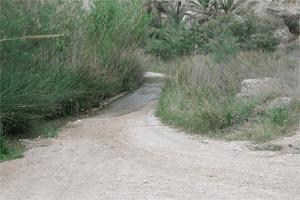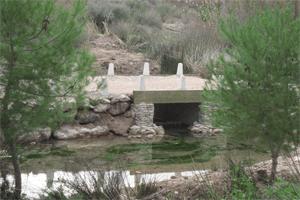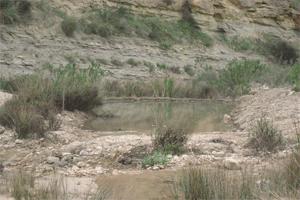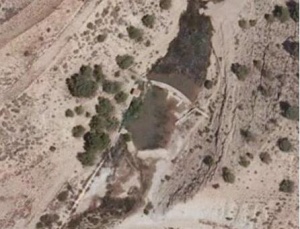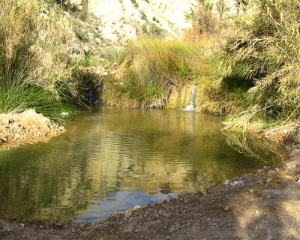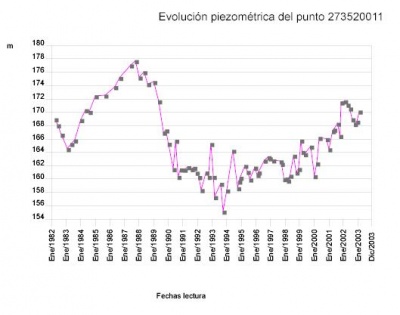Chícamo Life project. Conservation of Aphanius iberus´ genetics stocks ( Murcia ).
Chícamo Life project. Conservation of Aphanius iberus´ genetics stocks (Murcia ).
Key features of the case study
The Spanish toothcarp is a endemic fish of the Spanish Mediterranean coast, typical of changeable environment with still shallow waters, as river estuaries, swamps, coastal lagoons and lowland water bodies, due to its capacity to resist a wide range of salinity (euryhaline) and temperature (eurythermal). However, it has been displaced by invasive exotic species as Gambusia holbrooki (Eastern mosquitofish), and relegated to saline or hypersaline areas where mosquitofish can not live. The destruction of their natural habitat (see Extra background information ) is another cause of regression, that in addition accentuates the isolation and division into subpopulations.
Site description
Attention: the source of the following text is the Chícamo river project web site[1]:
The Chícamo river is located within the SCI of the Chícamo River (SCI ES6200028) . There are 8 habitats of community interest.
The Chícamo River rises near Macisvenda, a small village belonging to the Abanilla municipal district, one of the most arid places in Murcian Region, which gives this scenery a special peculiarity.
It is a permanent flow river stretch with related temporary watercourses and wetlands. You can find different community plants such as Nerium oleander (Rosebay), Tamarix boveana and Tamarix canariensis ; also, some endemic plants as Sideritis leucantha and Thymus moroderi .
In terms of fauna, stands out Spanish toothcarp ( Aphanius iberus ), the only presence of this species in continental courses in Murcian Region, and the invertebrate Coenagrion mercuriale (Southern Damselfly), both including on Annex II of Directive 92/43/CEE; as well as Himantopus himantopus ( Black-winged Stilt) , included on Annex I of Directive 79/409/CEE.
The Chícamo River source is a natural river stretch with a length of bed fewer than 3.5 km , 1.5 m of average width and no more than 75 cm of depth.
Measures selection
The whole project comprises actions at different places of Murcia: Ajauque's wetland and “Rambla Salada”, Marchamalo” saltflats, "Rasall" saltflats and the he Chícamo river. While the actions at the Chicamo river and Marchamalo saltflats were aimed to increase the physical habitat availability, the Rambla Salada´s complex rehabilitation was destined to create a centre for re-establish and semi-captivity control of a “Chícamo” River stock population, and the restoration of the “Rasall” saltworks aimed to re-establish a Spanish toothcarp population that belongs to the genetic stock who lives in “Marchamalo” saltflats.[2]
Particularly, the measures at the Chícamo river consisted in[3] :
- Create a water intake through the rehabilitation of an old channel, so the farm machinery doesn´t have to reach the river for take water.
- Two bridges were constructed to to prevent vehicles driving through the riverbed itself, and some tracks were diverted. At the same time, the channel at these places was restored in order to increase the aquatic habitat.
- The main natural pool and artificial pools created by previous projects were restored. The excess of aquatic vegetation and sediments were removed. Pools were transformed to become deeper, (around 75 cm depth)to avoid their filling up, but taking into account the habitat preferences of the spanish toothcarp. their surface was also amplified, to increase the habitat available.
- New pools were established, sometimes using the structure of former tracks. Upstream and downstream of La Umbría weir, two pools were established taking the opportunity that the channel, which was tubed untill 2005, was already undergoing a naturalization process.
- Invasive species control (Gambusia holbrooki and Procambarus clarkiiin) byactive and passive methods of fishing.
- Release of 127 individuals from the captive-breeding program to reinforce the existing population of Spanish toothcarp.
- Monitoring and evaluation of abundance and structure of Spanish toothcarp´s population, available habitat (physical-chemical parameters), monitoring and evaluation of invasive species populations, monitoring of the population reinforcement activities.
- Create a water intake through the rehabilitation of an old channel, so the farm machinery doesn´t have to reach the river for take water.
For more images of the project, visit the web site:
http://www.carm.es/siga/europa/life0035/ingles/en1024768/f-chicamo.htm
Success criteria
- Recovery of Aphanius iberus populations.
- Recovery of Aphanius iberus populations.
- Increment of Aphanius iberus populations in their natural and potential areas.
Ecological response
The study of the population evolution done at two sites near the Chícamo river´s source revealed different conclusions[4].
- The density was always higher at the site CH01 than at the site CH02. The population at CH01 is stable but fragile, even if the sampling shows an increase in the population density from 2007, probably due to the habitat improvement measures.
- The absence of A. iberus at CH02 at the end of the project makes the efforts for reintroduce the species at this site a priority.
- The analysis of size frequency distributions enables to confirm the acceptable status of the population despite their low densities. Since the summer of 2007, there was a slight improvement in the population structure.
- The habitat analysis suggests that A. iberus prefers those pools with an intermediate depth(between 15 and 25 cm) and substrates consisting of clay and silt. Probably, this situation is determined by the greater availability of food and lower interspecific competence.
- The extraction of exotic species seemed to be effective for the population control. The probability of finding mosquitofish is scarce, and the densities of P. clarkii are maintained in low values.
- The establishment of artificial pools is a good practice for the recovery of Spanish toothcarp population, but must be complemented with the control of invasive species for optimum results. Thus, monitoring the population of established Spanish toothcarp, together with potential risk of gambusia population recovery of the population of mosquitofish, should be management actions to perform in the post-LIFE.
- The density was always higher at the site CH01 than at the site CH02. The population at CH01 is stable but fragile, even if the sampling shows an increase in the population density from 2007, probably due to the habitat improvement measures.
Hydromorphological response
Increasing the habitat availabe seems to be a necessary measure for the conservation and development of an endangered species like the Spanish toothcarp. The restored sites showed an increase in deeper areas (augmentation of the average depth) and in the area covered by water (augmentation of the distante to the shore) as a result of the restoration measures.
The establishment of semi-artificial pools or ponds with continuous circulation within the main channel has proved to be a suitable tool to expand the aquatic habitat. However, this tool needs the complement of invasive fish population control (gambusia) for optimum results.
Monitoring before and after implementation of the project
Before the implementation of the project, the initial status of the Spanish toothcarp population at the Chícamo river was evaluated. For that purpose, the area with presence of the fish was determined in the reach from the river source until the locality of Mahoya.The location was specified in a 100 x 100 m UTM grid. the results of the initial evaluation revealed the presence of Aphanius iberus only in 4 cells of the grid, located by the source of the river and near the Cajel dam.
During the implementation of the project the spatial and temporal evolution of the fish population abundance and structure was studied, and so physico-chemical conditions of the aquatic habitat, the evolution of habitat avaiability, the fish habitat preference (depth, substrate granulometry), and the evolution of invasive species abundance (Gambusia holbrooki, Procambarus clarkii) in response to control measures. There is also a post-release Monitoring Program for evaluate the success or failure of the population reinforcement through the release of captive-bred specimens.[5]
Socio-economic aspects
The project had a total budget of 1.148.668 €. The LIFE contribution was of 574.334 €.
Contact person within the organization
- Jose Antonio Martínez García
- Dirección General del Medio Natural
- Consejería de Desarrollo Sostenible y Ordenación del Territorio
- Comunidad Autónoma de la Región de Murcia
- C/ Catedrático Eugenio Úbeda nº 3 - 3ª Pl. 30008 MURCIA
Extra background information
Chícamo river permanent flow comes from the Quibas free aquifer, which has 270-310 km2 and is feed by rainwater infiltration. Only 10 km of the river maintain permanent or temporal flow, since the river nature is truly sporadic. In addition,the river stays dried downstream El Partido (at 7 km from the source), where a weir diverts the water for irrigation. Only in those places where the water from the aquifer comes up, the river regains flow, but with a higher salinity.
The Chícamo was used for irrigation since Roman times, but the aquifer became overexploited from the 70´s. In 1973, even if the overexplotation was already known, the groundwater flow followed the natural tendency. In 1975, a division of the aquifer into two subunits was detected, coinciding with a maximum in the extraction, estimated in 25 Hm3/year. The magnitude of the extractions oscillated much between 1970 and 1990, although the amount of water extracted has always exceeded the aquifer natural rate of recharge (estimated in 2,5 Hm3/year for 1987)[6]. In 1989 the groundwater extraction was calculated in 5,98 Hm3/year, and the natural discharge into the river was estimated in 0,8 Hm3/year (1987). According to the available information the natural recharge is estimated in 5,5 Hm3/year, the natural discharge in 1 Hm3/year, and the extractions in 7,5 Hm3/year (1997)[7]. The piezometric levels descended around 120-130 m between 1970 and 1990. During the last years the levels have experienced a slight increase, but still the aquifer is fragmented into several subunits that function independently. The reduction in water extraction is due to the increment in the cost of pumping and the deterioration of the water quality. The aquifer has an average conductivity of 7,074 mS/cm (ranging from 2,200 mS/cm and 24,100 mS/cm) and an average value for nitrates of 17 mg/l (0-93 mg/l)[8]. It also suffers natural contamination of Chloride, Sodium, Magnesium, Sulphate and Calcium originated by saline materials. Nowadays the whole aquifer is affected by salinization and overexploitation, and the process for declare it offcially has been initiated by the Confederación Hidrográfica del Segura.
Since 1989 neighbours and ecologist protested about the decline of flows. In the opposite side, the farmers claimed the river channelization for diverts the water from the natural channel 6 km. The last finally happened, leading to the total degradation of the river. In 1994 a flooding broke the channel, making useless the structure and paralyzing the conflict untill 1998, when it was restored.
In 1998 the population of Spanish toothcarp at the upper part of the Chícamo river was discovered. In 2000 it was declared the SCI ES6200028 "Río Chícamo".
In 2004 the European Commission aproved the funding for this project. The actions in the Chícamo river are part of a larger project which pretend the long term conservation of the Aphanius iberus in the Murcian region.
The operational objectives are: [9]
- Protect natural populations and their habitats (OPGs).
- Re-establish 2 new viable OPGs (Operative Population Groups), one continental (“Rambla Salada”) and other coastal (“Rasall” saltworks).
- Establish 4 refugees OPGs, 2 continental areas (the “Chícamo” River and “Rambla Salada”) and 2 coastal areas (“Marchamalo” saltworks and “Rambla del Rasall”).
- Monitoring natural.
- To determine factors affecting population persistence.
- Information and Environmental Education.
- Information and Environmental Education.
References
- ↑ [1]
- ↑ [2]
- ↑ Technical report.Actuaciones realizadas y evaluación de su efectividad en la cabecera del río Chícamo. 2008. [3]
- ↑ Technical report.Actuaciones realizadas y evaluación de su efectividad en la cabecera del río Chícamo. 2008. [4]
- ↑ Technical report.Actuaciones realizadas y evaluación de su efectividad en la cabecera del río Chícamo. 2008. [5]
- ↑ Instituto Geológico y Minero de España, 1995 [6]
- ↑ DGOHCA-ITGE (1997). Catálogo de acuíferos con problemas de sobreexplotación o salinización. Predefinición del programa de actuación (convenio DGOHCA-ITGE). [7]
- ↑ DGOHCA-ITGE (1998). Calidad y contaminación de las aguas subterráneas. Propuestas de protección. DGOHCA-ITGE (1997). Catálogo de acuíferos con problemas de sobreexplotación o salinización. Predefinición del programa de actuación (convenio DGOHCA-ITGE). www.igme.es
- ↑ Web site of the project [8]
Related Measures
- Remove barrier
- Remove sediments
- Remove or modify in-channel hydraulic structures
- Other measures
- Restore wetlands
- Construct semi-natural/articificial wetlands or aquatic habitats
